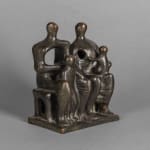Henry Moore 1898-1986
14 x 11.4 x 7.5 cm
Henry Moore’s postwar, semi-abstract sculptures known as Family Groups are some of his most prominent artworks, the theme was explored at least fourteen times between 1944 and the early 1950s. In this period, he filled nearly two sketchbooks with drawings presenting family groups in different poses, which he realised as maquettes before settling on a design to be made into four monumental sculptures, such as Family Group, 1954–5.
The conception of this sculpture lies in the 1930s, when the German architect Walter Gropius proposed to Moore that he make a large-scale sculpture for his progressive school. Instead of just building a school, Gropius was going to make a centre for the whole life of the surrounding villages, and Family Group would represent the centre of it, the family as the basic unit.
This bronze, perhaps his most daring experimentation of the idea, is one of the most abstract family groups, being informed by modernism and primitivism, alongside contemporary events of his private life and the horrors of war. The totemic piece represents a father, mother, and two children who are not directly gazing at each other and cannot be comprehended from a single perspective. This 1946, Family Group, was cast at the Art Bronze Foundry, London, and produced to be sold privately, providing more opportunities to sell his pieces, and signalling a shift in his working practice ‘clay, plasticine and plaster would replace drawings as his primary means of generating ideas’. The original three-dimensional model for the sculpture was made in clay. In addition to this maquette, Moore made at least thirteen other clay models of family groups. Ten of these models were cast in bronze editions, three of which are held in the Tate collection and are the earliest works of the artist to have been collected by the institution.
The use of bronze brought a greater fluidity and rhythm to Family Group: one must follow the curvilinear surface of the bronze to discover each of several relations between the members of the family, mainly experienced in their physical contact and expressed in their sculpted unity. Moreover, concerning its uniqueness, it is one of the only maquettes involving the hollowed out paternal figure, perhaps evocative of Moore’s own experience of becoming a father during the war. The subtractive sculptural process and ample presence of holes and niches is one of Moore’s art's most striking features, as he himself explained in 1937, 'The first hole made through a piece of stone is a revelation. The hole connects one side to another, making it immediately more three-dimensional. A hole can have as much shape-meaning as a solid mass. Sculpture in air is possible, where the stone contains only the hole, which is the intended and considered form' (Henry Moore, A Sculptor Speaks, Listener, 18 August 1937).
Family Group maquettes are in the collections of the Museum of Modern Art in New York, and Tate in London.
Provenance
Valentin Gallery, New York;Private collection;
Landau Fine Art, Canada;
Private collection, Switzerland
Exhibitions
1972, Small Bronzes and Drawings by Henry Moore, Lefevre Gallery, London, cat.no 11 (ill.in b&w p.29)Literature
Henry Moore: Sculpture and Drawings 1921-48, Volume 1, Lund Humphries Publishers, London, 1957, cat.no.235;Henry Moore: Sculpture and Drawings 1921-69, Thames & Hudson, London, 1970, cat.no.343
Join our mailing list
* denotes required fields
We will process the personal data you have supplied to communicate with you in accordance with our Privacy Policy. You can unsubscribe or change your preferences at any time by clicking the link in our emails.




